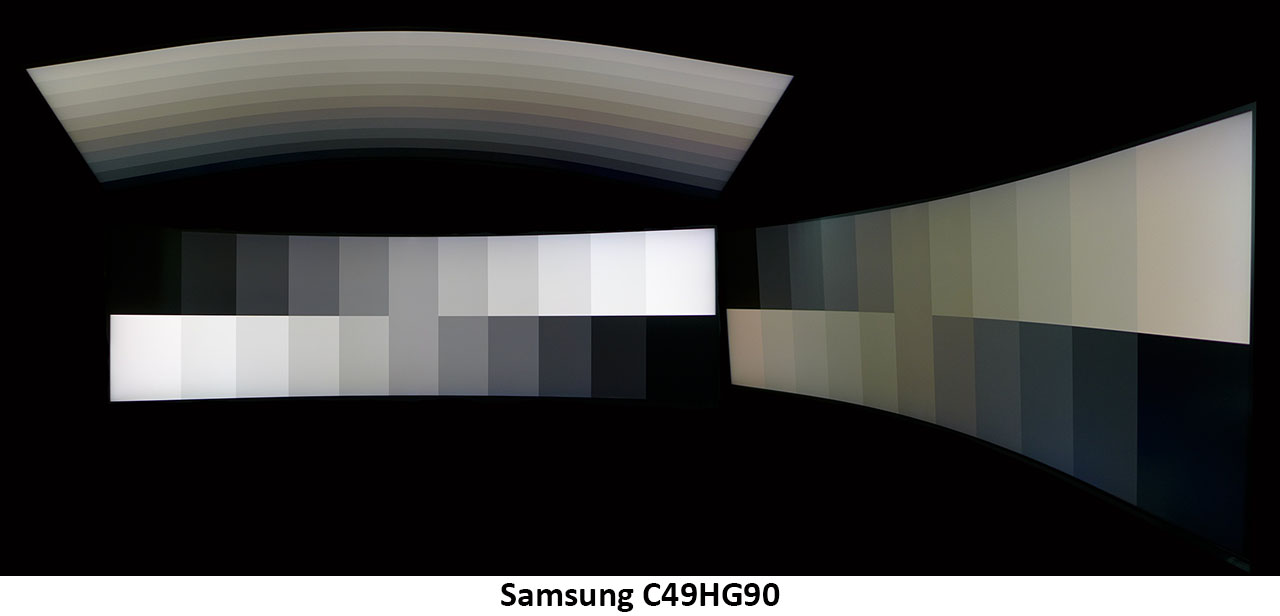Samsung CHG90 Review: No More Dual-Monitor Gaming
Debating a multi-screen setup? This bad boy can replace two 27-inch 16:9 monitors.
Why you can trust Tom's Hardware
Viewing Angles, Uniformity, Response & Lag
Viewing Angles
It would be difficult to use more than 1 of these monitors in a desktop configuration. Its sheer width makes that an unlikely proposition, and the viewing angles confirm that. VA panels are inferior to IPS (in-plane switching models) in this regard but still better than TN (twisted nematic) panels. Fortunately, the head-on view is just fine. You could be sitting 3 feet away from this monitor, and when you turn your head, the image looks the same at all angles. But we don't recommend sitting off to the side. This screen is not for sharing. The light falloff at 45° is at least 60%, and you’ll see an obvious shift to green. From above, detail is almost completely invisible, and output is at least 50% lower.
Screen Uniformity
To learn how we measure screen uniformity, click here.
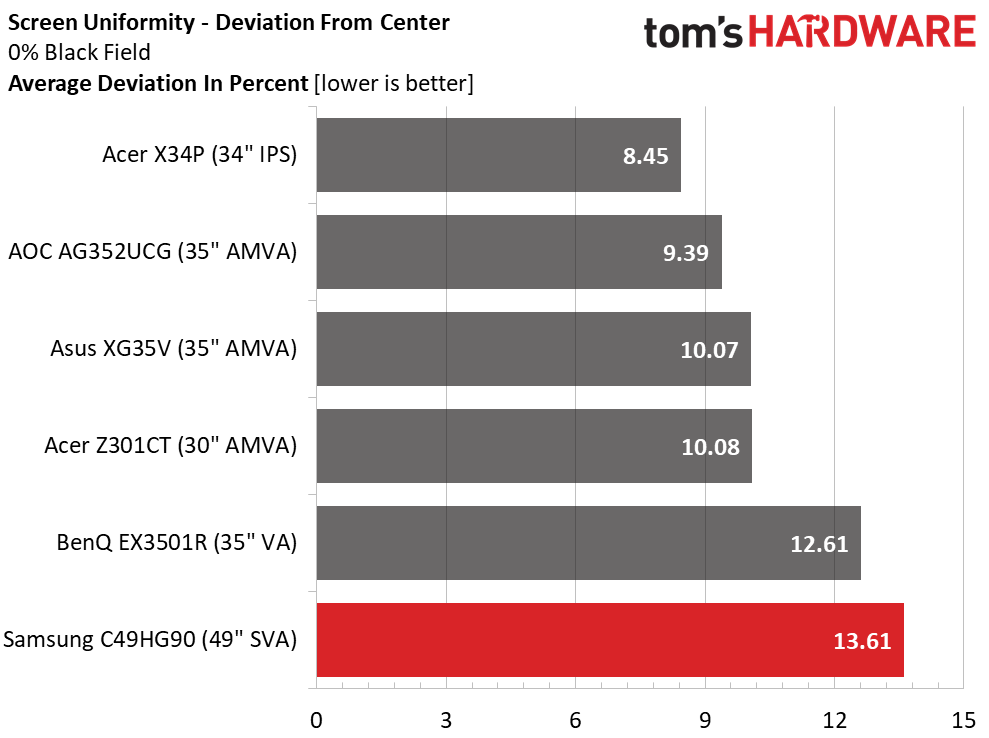

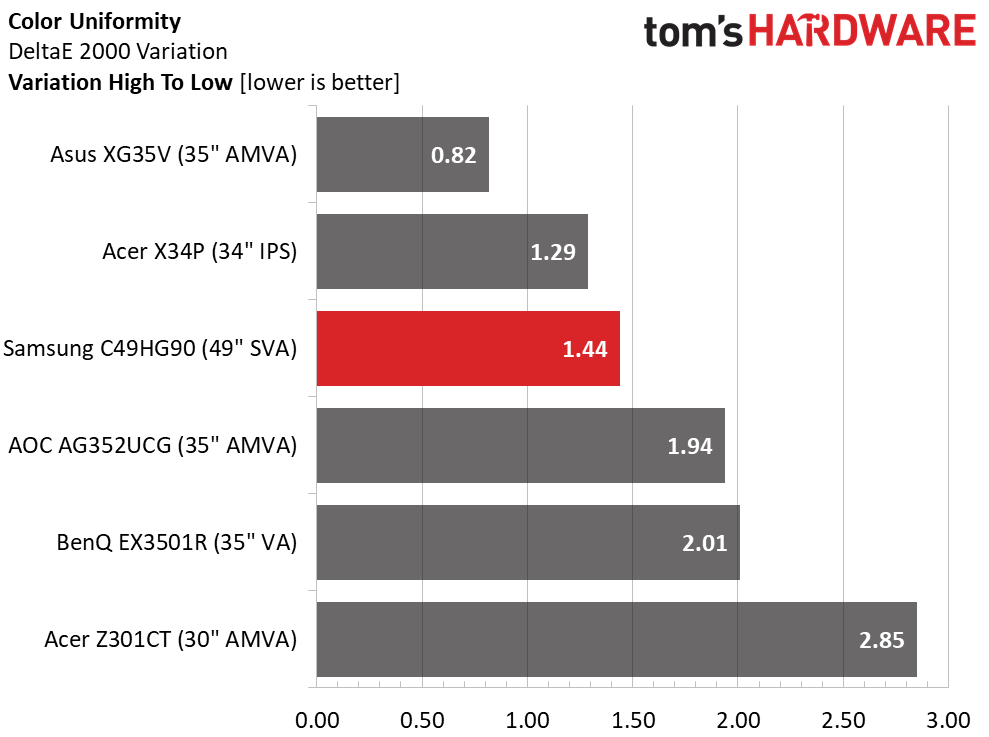
We wondered how the CHG90’s extreme curve and width would affect its uniformity. Luckily, it measured quite well. This monitor isn’t cheap, so we’re glad to see good quality control here. The black field result is only a tad higher than average, and the white field score is right up there with the best. The upper left and lower right zones of our sample showed a slightly elevated black level. The 100% field showed no issues. Color uniformity is excellent at a very low 1.44dE variation.
Pixel Response & Input Lag
Click here to read up on our pixel response and input lag testing procedures.
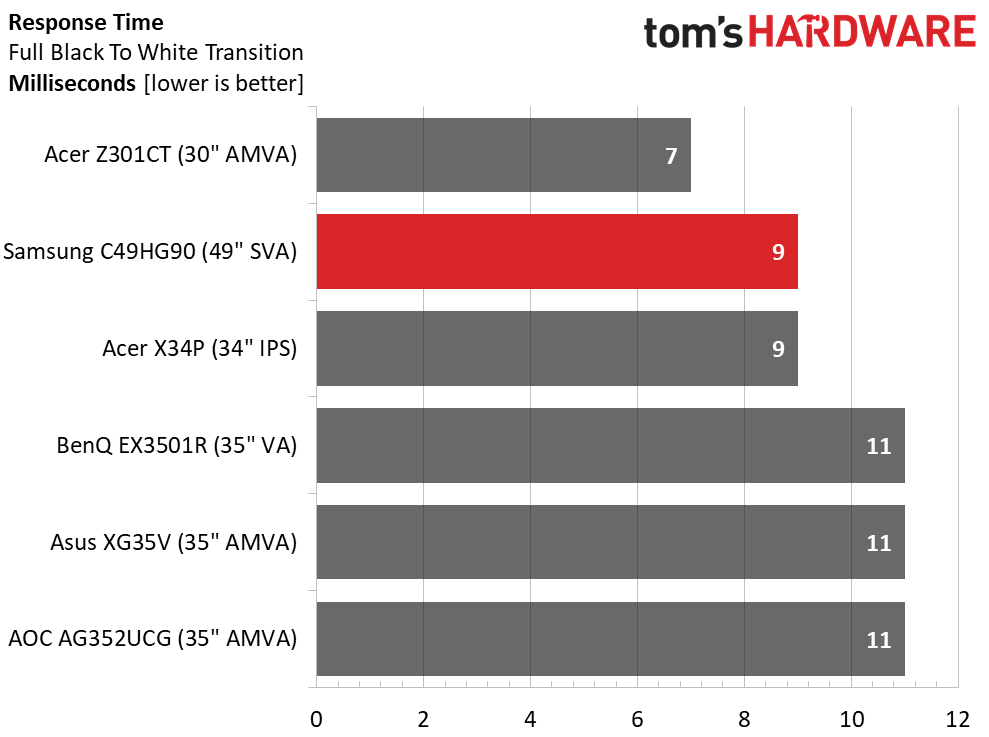
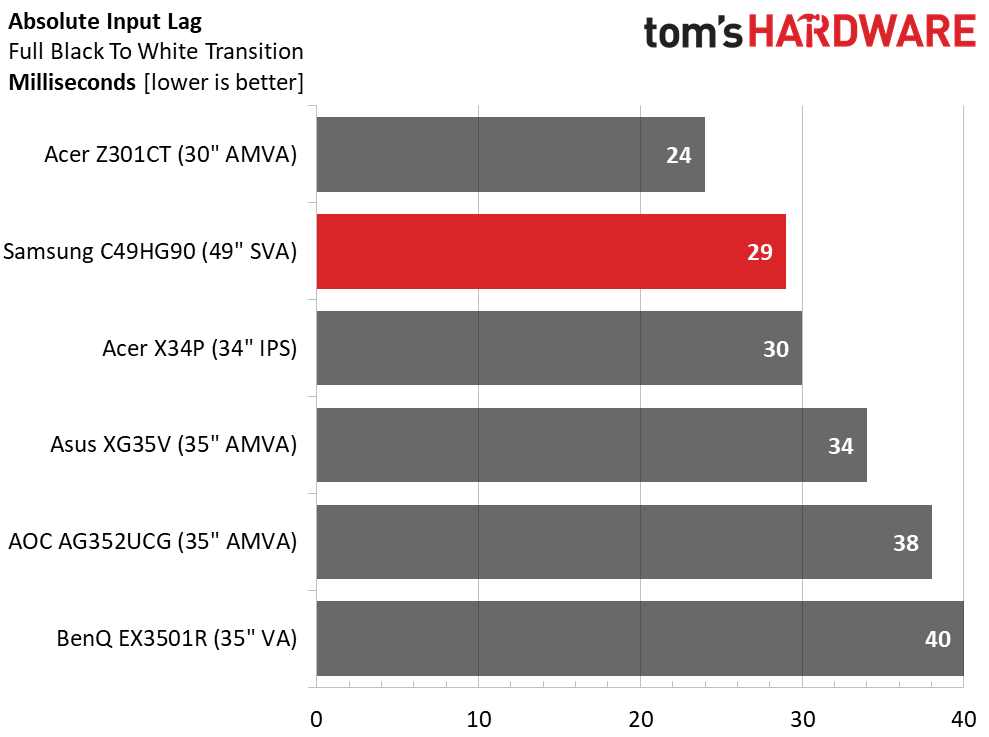
The CHG90 is one of the faster ultra-wides we’ve reviewed, topping all but the 200Hz Acer Z301CT in our response and lag tests. There is no blur-reduction feature, but it is completely unnecessary at the frame rates this monitor produces. 1,080 vertical pixels means high speeds with a wide variety of mid and high-priced video cards. With just 29 milliseconds of input lag, fast-moving shooters were a breeze to play with no perceivable latency whatsoever.
Gaming With FreeSync
Now to discuss CHG90’s resolution some more. Yes, detail isn’t quite as sharp as one would see in QHD or UHD. And there are instances of jaggies here and there. But the wraparound effect is nothing short of amazing. Users of multiple screens will have already tasted this experience. And it can only be better when those dividing lines are gone. We found ourselves just running around the game’s environment and exploring because it was so much more real. To have this much image in one’s peripheral vision is something that can’t be duplicated with any other kind of monitor.
Response is equal to the best gaming displays we’ve reviewed. Lag is non-existent, and blur is minimal. Overdrive is locked to the on position when FreeSync is active and doesn’t create any ghosting. Its effect is a bit conservative though. When we moved the mouse fast enough, we saw a tiny bit of judder in areas of high contrast. But with adaptive refresh down to 36Hz, we didn't see a single tear, even with detail maxed. That low resolution will help owners of older video cards, like our AMD Radeon R9 285.
Get Tom's Hardware's best news and in-depth reviews, straight to your inbox.
It’s important to remember the additional quality afforded by the CHG90’s excellent contrast. While we look forward to the day when HDR gaming is common, today’s SDR material looked fantastic on the monitor. Black levels were deep and detailed, while highlights popped right out from the background. The 3D effect here was palpable. Fine textures were rendered with a real tactility that can’t be achieved on a 1000:1-contrast IPS screen.
MORE: Best Gaming Monitors
MORE: How We Test Monitors
MORE: All Monitor Content
Current page: Viewing Angles, Uniformity, Response & Lag
Prev Page HDR Grayscale, EOTF & Color Next Page Conclusion
Christian Eberle is a Contributing Editor for Tom's Hardware US. He's a veteran reviewer of A/V equipment, specializing in monitors. Christian began his obsession with tech when he built his first PC in 1991, a 286 running DOS 3.0 at a blazing 12MHz. In 2006, he undertook training from the Imaging Science Foundation in video calibration and testing and thus started a passion for precise imaging that persists to this day. He is also a professional musician with a degree from the New England Conservatory as a classical bassoonist which he used to good effect as a performer with the West Point Army Band from 1987 to 2013. He enjoys watching movies and listening to high-end audio in his custom-built home theater and can be seen riding trails near his home on a race-ready ICE VTX recumbent trike. Christian enjoys the endless summer in Florida where he lives with his wife and Chihuahua and plays with orchestras around the state.
-
lhughey 1080p? Hard pass on this. It needs at least 1440 and 1600 would be better. I know that diminishes the market for this, but people willing to pay $1000 for a monitor are going to be have a strong video card. Nvidia is about to drop a new generation of cards also, so the entry to 3840*1600 is about to move down to GT2070 series.Reply -
Fait When someone comes out with one that is 4k HDR10+ G-sync and 144 or 240Hz, then I will get excited. The specs here just aren't that impressive.Reply -
milkod2001 Dear Samsung. Drop the facking curve, make it 32'' 4k, 100Hz, factory calibrated and we all be happy. Kind regards Most customers.Reply -
SkyBill40 I saw one of these in the wild recently. It was, in a word, impressive. That said, the 1080p resolution is likely a no go for many despite the high refresh rate and excellent quality VA panel. The curve doesn't appeal to everyone but having a smooth rather than flat view in terms of peripheral vision is pretty much a requirement for something of this size. If I had the desk space for it, I would definitely be in the market... much to my wife's dismay.Reply -
Alpha Gametauri Ehh, i think i will stick with my Alienware 3418DW's at 3440x1440 res, 120hz, and GSync. Plus, i'm dual screening either way.Reply -
10tacle Yeah I immediately lost interest when I read it was 1080 on the vertical resolution. I can't stand that pinched look and lacking in vertical resolution with a super wide screen even at 21:9 aspect ratio, let alone this one at 32:9. To me it's like looking at a monitor with eyes half closed. I remember losing my 16:10 ratio 25.5" Samsung 1920x1200 monitor and upgrading to a 16:9 27"1440p monitor. It took a while to get used to the loss of vertical height even though it was a resolution upgrade.Reply
But it's nice to see a true 10-bit panel of this size in a sub-$1,000 (USD) price range, so kudos for Samsung on that. Just give me more vertical resolution on these extreme ulrawides and I'm sold.
21240082 said:If I had the desk space for it, I would definitely be in the market... much to my wife's dismay.
That's what kills me about women. We men have to fight for a little master bedroom closet space for our few clothes and shoes while they pack it wall to wall with their ever growing clothes and shoe collection from weekend shopping trips. Then we are lambasted for wanting our tech toys which are only purchased once every several years. -
SkyBill40 Reply21240211 said:21240082 said:If I had the desk space for it, I would definitely be in the market... much to my wife's dismay.
That's what kills me about women. We men have to fight for a little master bedroom closet space for our few clothes and shoes while they pack it wall to wall with their ever growing clothes and shoe collection from weekend shopping trips. Then we are lambasted for wanting our tech toys which are only purchased once every several years.
To be honest, she's really not that bad. She doesn't like that gaming is a hobby of mine and feels it to be a wasteful time sink, but she is fine with me doing my thing when I feel like doing it. Beyond that, I just have some exceedingly expensive hobbies: firearms, computing, high end A/V, and cars. :/
While I could probably make it work (or any other for that matter), I hold off due to her sacrificing for the greater good and spending money on our house and such rather than expensive individual things with limited purpose. It's fine... though I won't lie that I *am* in the market for a new display as my 1920*1200 60Hz Samsung is long in the tooth and holding back my beastly 1080. -
bolkar Such a waster opportunity. 1080p vertical? really? This beast have half the pixels of my 27 inch 4K monitor, even though this is 49inch. Double the pixels on both directions then we have something to talk about...Reply
